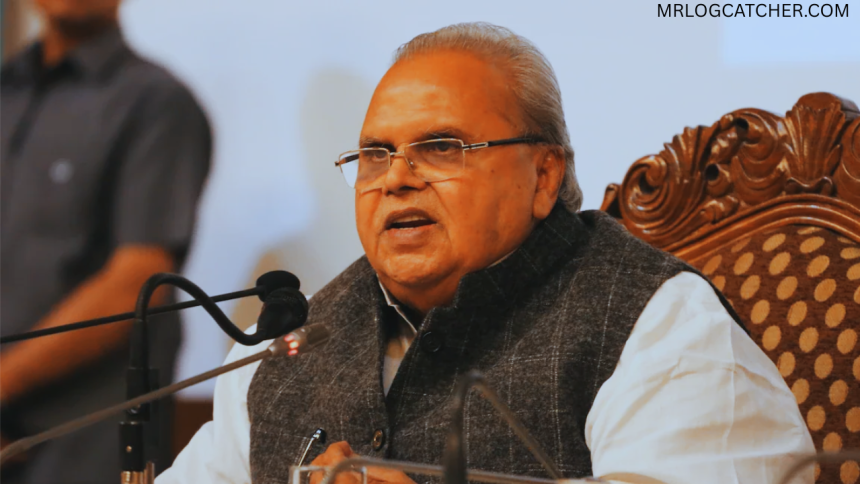Satya Pal Malik is a name that evokes mixed emotions in India’s political landscape. A seasoned politician with decades of experience across party lines, Malik rose to national prominence in recent years not only for his administrative roles but also for his bold, controversial statements. His tenure as Governor of several Indian states—particularly Jammu and Kashmir—marked a turning point in his public life, culminating in both praise and scrutiny. In May 2025, his name once again dominated headlines as the Central Bureau of Investigation (CBI) filed a chargesheet against him in connection with the ₹2,200-crore Kiru Hydropower Project corruption case.
This article offers a detailed look into Malik’s life, his political career, the controversies surrounding him, and the latest developments in the corruption investigation.
Early Life and Education
Born on July 24, 1946, in Hisawda village, Baghpat district, Uttar Pradesh, Satya Pal Malik hails from a Jat farming family. He completed his B.Sc. and later earned a law degree (LLB) from Meerut College. From his student days, Malik was known for his keen interest in politics, actively engaging in debates and youth movements of the era.
Political Career: An Ideological Journey
Malik’s political journey began with Chaudhary Charan Singh’s Bharatiya Kranti Dal in the 1970s. In 1974, he was elected as a Member of the Uttar Pradesh Legislative Assembly. His political affiliations have evolved over the years, including stints with:
- Janata Dal
- Indian National Congress
- Samajwadi Party
- Bharatiya Janata Party (BJP)
He served as a Member of Parliament in the Rajya Sabha from 1980 to 1989 and was elected to the Lok Sabha from Aligarh in 1989. Malik also held the post of Union Minister of State for Parliamentary Affairs and Tourism in 1990.
His flexibility across party lines earned him the reputation of a political survivor and an administrator capable of navigating India’s complex political fabric.
The Governor Years: Administrative Roles Across India
From 2017 onward, Satya Pal Malik served as Governor in five different Indian states and union territories, gaining wide administrative experience and attracting public and media attention.
Bihar (2017–2018)
Malik’s first gubernatorial posting was in Bihar, where he was appreciated for a straightforward and accessible administrative style.
Odisha (Additional Charge, 2018)
For a brief period in 2018, he also held the additional charge of Odisha.
Jammu and Kashmir (2018–2019)
This tenure would become the most defining of his career. Appointed as the Governor of Jammu and Kashmir in August 2018, Malik oversaw the revocation of Article 370 in August 2019—a watershed moment in Indian politics. The move led to the bifurcation of the state into two Union Territories and sparked both domestic and international reactions.
Malik supported the decision publicly, although in later interviews, he revealed critical insights about the government’s handling of security and communication post-370 abrogation, including the Pulwama terror attack.
Goa (2019–2020)
Malik served as the Governor of Goa for about nine months. His tenure was relatively low-key but saw moments of friction with the state government over governance and corruption issues.
Meghalaya (2020–2022)
In Meghalaya, Malik continued his outspoken approach, openly criticizing the central government on issues like farmers’ protests and governance lapses, earning both praise and condemnation.
Whistleblower or Political Maverick?
After demitting office, Satya Pal Malik increasingly voiced criticisms against the ruling establishment, particularly regarding the farmers’ protest and the Pulwama attack.
On the Farmers’ Protest
Malik gained public support among farmers for criticizing the Modi government’s handling of the 2020–2021 farmers’ protest. He claimed that the government was indifferent and delayed action that could have prevented avoidable tragedies during the protests.
On the Pulwama Attack
In 2023, Malik made headlines by stating that the Pulwama attack—where 40 CRPF personnel were killed—was the result of an “intelligence and security failure.” He alleged that the central government suppressed facts related to the incident.
These remarks, while seen by many as courageous, invited backlash from ruling party supporters and increased scrutiny of his own conduct.
The Kiru Hydropower Project Corruption Case
Background
The Kiru Hydropower Project is a ₹4,288-crore hydroelectric project in Jammu and Kashmir aimed at providing clean energy. In 2021, Malik publicly stated that he was offered a ₹300-crore bribe to approve certain files related to the project, including one concerning contractor selection.
This disclosure triggered a preliminary CBI inquiry.
CBI Investigation and Chargesheet
On May 22, 2025, the CBI filed a formal chargesheet against Satya Pal Malik and six others. The charges include irregularities in awarding a ₹2,200-crore civil works contract to Patel Engineering Ltd. without proper tendering procedures.
The accused in the case include:
- Satya Pal Malik
- Two former private secretaries
- Officials from Chenab Valley Power Projects Pvt Ltd
- Executives from Patel Engineering
Despite the charges, Malik has maintained that he acted in public interest and refused to approve the deal under pressure.
Hospitalization and Health Concerns
Hours after the chargesheet was filed, Malik posted a photo from his hospital bed at Ram Manohar Lohia Hospital in Delhi. He revealed that he was undergoing kidney dialysis and that his condition was “very serious.” The post added emotional weight to the unfolding legal drama, drawing sympathy from supporters and silence from many political quarters.
Public Perception and Political Legacy
Satya Pal Malik remains a polarizing figure. For some, he is a whistleblower—courageous, honest, and willing to risk his reputation to speak the truth. For others, he is a political opportunist who used controversy to stay relevant.
Strengths
- Vocal Advocate: Known for calling out corruption and speaking plainly, even at personal risk.
- Experienced Administrator: Held gubernatorial positions in complex regions.
- Supporter of Farmers: His vocal support for farmers won him trust in rural India.
Criticisms
- Timing of Disclosures: Many question why he made key revelations only after leaving office.
- Political Flip-Flopping: His frequent party shifts have drawn criticism about ideological consistency.
- Now Facing Legal Scrutiny: The corruption charges raise doubts about his own conduct.
Reactions from the Political Spectrum
- Opposition Leaders: Praised Malik’s courage in calling out corruption and authoritarianism.
- BJP and Allies: Have largely avoided commenting on the chargesheet.
- Civil Society: Mixed reactions—some view him as a whistleblower, others see political theatrics.
What Lies Ahead?
Legal Battle
Malik now faces a prolonged legal fight that could define his legacy. With his health in decline, the case’s timeline may become a point of humanitarian and legal contention.
Impact on Indian Politics
His case raises critical questions about whistleblower protections, the integrity of administrative processes, and the politicization of anti-corruption probes.
Potential for Political Memoir
Given his insider knowledge and bold opinions, a memoir or tell-all book from Malik could stir further debate and reshape public perception.
Conclusion
Satya Pal Malik’s story is far from over. A man who once operated behind closed doors as a governor is now fighting a very public battle. Whether viewed as a fearless truth-teller or a flawed political figure, Malik’s journey encapsulates the complexities of Indian democracy, where idealism often clashes with realpolitik.
His legacy—like his career—is marked by contradictions, courage, and controversy. Only time will reveal the full extent of his impact on India’s political narrative.
Would you like this article formatted for a WordPress blog or HTML page? I can prepare that as well.











